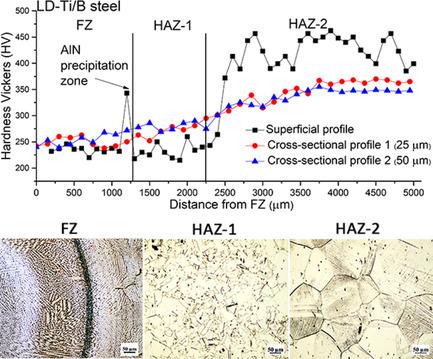当前位置:
X-MOL 学术
›
Steel Res. Int.
›
论文详情
Our official English website, www.x-mol.net, welcomes your
feedback! (Note: you will need to create a separate account there.)
Metallographic, Structural, and Mechanical Characterization of Weld Nuggets in Fe–Mn–Al–C Low-Density Steels Microalloyed with Ti/B and Ce/La by Gas Tungsten Arc Welding Process
Steel Research International ( IF 1.9 ) Pub Date : 2021-07-06 , DOI: 10.1002/srin.202100229 Carlos Enrique Coronado-Alba 1 , Ignacio Mejía 1 , José María Cabrera 1, 2
Steel Research International ( IF 1.9 ) Pub Date : 2021-07-06 , DOI: 10.1002/srin.202100229 Carlos Enrique Coronado-Alba 1 , Ignacio Mejía 1 , José María Cabrera 1, 2
Affiliation

|
The use of low-density (LD) steels has become increasingly important due to the advantages they offer, such as high strength, high ductility, and principally weight reduction. However, there are few studies regarding their weldability by conventional processes due to the metallurgical complexity of these alloys, including kappa carbides precipitation and hot-cracking associated with the high contents of Mn, Al, and C. Herein, the main objective is the characterization of the fusion zone and different heat-affected zones of austenitic Fe–Mn–Al–C LD steels microalloyed with Ti/B and Ce/La. For this purpose, weld nuggets were prepared by autogenous gas tungsten arc welding process using heat inputs of 660 and 975 J. The weld nuggets were characterized metallographic, structural, and mechanically by light optical microscopy, scanning electron microscopy, X-ray diffraction, and Vickers microhardness. In general, weld nuggets shows three well-defined zones where γ-austenite is the main phase and AlN and MnS particles act as nuclei of complex precipitated particles of microalloying elements such as TiC and (Ce, La)O. A considerable decrease in hot-cracking was noticed in the microalloyed grades. A modulated structure of kappa-carbide particles was responsible of the largest hardness values (≈450 Vickers microhardness) in the second heat-affected zone.
中文翻译:

通过钨极氩弧焊工艺对 Ti/B 和 Ce/La 微合金化的 Fe-Mn-Al-C 低密度钢中焊核的金相、结构和机械表征
由于低密度 (LD) 钢具有高强度、高延展性和主要减轻重量等优点,因此它们的使用变得越来越重要。然而,由于这些合金的冶金复杂性,包括与高含量的 Mn、Al 和 C 相关的 kappa 碳化物析出和热裂纹,关于它们通过常规工艺的可焊性的研究很少。在此,主要目的是表征Ti/B 和 Ce/La 微合金化奥氏体 Fe-Mn-Al-C LD 钢的熔合区和不同热影响区。为此,使用 660 和 975 J 的热输入通过自生钨极氩弧焊工艺制备焊点。通过光学显微镜对焊点进行金相、结构和机械表征,扫描电子显微镜、X 射线衍射和维氏显微硬度。通常,焊点熔核显示三个明确定义的区域,其中 γ-奥氏体是主要相,AlN 和 MnS 颗粒作为微合金元素(如 TiC 和 (Ce, La)O)的复杂沉淀颗粒的核。在微合金化等级中观察到热裂的显着减少。κ-碳化物颗粒的调制结构是第二个热影响区中最大硬度值(≈450 维氏显微硬度)的原因。在微合金化等级中观察到热裂的显着减少。κ-碳化物颗粒的调制结构是第二个热影响区中最大硬度值(≈450 维氏显微硬度)的原因。在微合金化等级中观察到热裂的显着减少。κ-碳化物颗粒的调制结构是第二个热影响区中最大硬度值(≈450 维氏显微硬度)的原因。
更新日期:2021-07-06
中文翻译:

通过钨极氩弧焊工艺对 Ti/B 和 Ce/La 微合金化的 Fe-Mn-Al-C 低密度钢中焊核的金相、结构和机械表征
由于低密度 (LD) 钢具有高强度、高延展性和主要减轻重量等优点,因此它们的使用变得越来越重要。然而,由于这些合金的冶金复杂性,包括与高含量的 Mn、Al 和 C 相关的 kappa 碳化物析出和热裂纹,关于它们通过常规工艺的可焊性的研究很少。在此,主要目的是表征Ti/B 和 Ce/La 微合金化奥氏体 Fe-Mn-Al-C LD 钢的熔合区和不同热影响区。为此,使用 660 和 975 J 的热输入通过自生钨极氩弧焊工艺制备焊点。通过光学显微镜对焊点进行金相、结构和机械表征,扫描电子显微镜、X 射线衍射和维氏显微硬度。通常,焊点熔核显示三个明确定义的区域,其中 γ-奥氏体是主要相,AlN 和 MnS 颗粒作为微合金元素(如 TiC 和 (Ce, La)O)的复杂沉淀颗粒的核。在微合金化等级中观察到热裂的显着减少。κ-碳化物颗粒的调制结构是第二个热影响区中最大硬度值(≈450 维氏显微硬度)的原因。在微合金化等级中观察到热裂的显着减少。κ-碳化物颗粒的调制结构是第二个热影响区中最大硬度值(≈450 维氏显微硬度)的原因。在微合金化等级中观察到热裂的显着减少。κ-碳化物颗粒的调制结构是第二个热影响区中最大硬度值(≈450 维氏显微硬度)的原因。











































 京公网安备 11010802027423号
京公网安备 11010802027423号